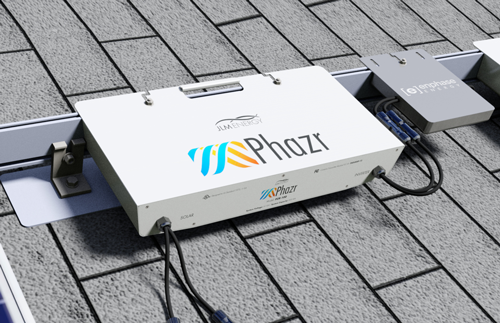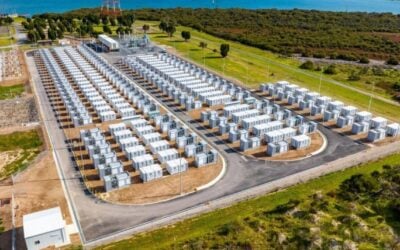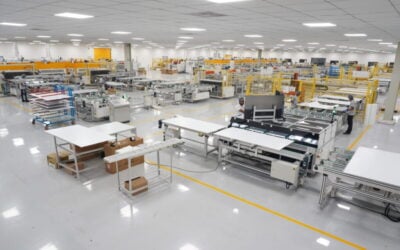
The CEO of a company that makes ‘microstorage’ units that connect directly to individual solar PV panels, says his products come with 20-year warranties with the intention of matching PV system owners’ expectations of product quality and lifetime.
JLM Energy CEO Farid Dibachi also said the ease of deployment of PV microinverters and module-level power electronics and their relative success in taking market share from string or central inverters was an inspiration to JLM in developing Phazr, its microstorage product.
Phazr units, launched at the beginning of this year, attach a small lithium battery to a solar PV panel. Building up from units of 0.65kWh or 0.8kWh, the systems can add 2.5 hours or 5 hours energy storage duration to a residential, commercial or utility-scale PV plant.
While many rivals in the lithium battery-based energy storage space are typically offering product warranties of five or 10 years, JLM’s Phazr units are backed with a 20-year assurance.
Try Premium for just $1
- Full premium access for the first month at only $1
- Converts to an annual rate after 30 days unless cancelled
- Cancel anytime during the trial period
Premium Benefits
- Expert industry analysis and interviews
- Digital access to PV Tech Power journal
- Exclusive event discounts
Or get the full Premium subscription right away
Or continue reading this article for free
“The customer is buying a solar panel and that panel is typically going to come with a 20-year warranty,” Dibachi said.
“If I truly want to offer a solar-plus-energy storage system to a customer accustomed to that 20-year warranty from a PV panel provider, I really need to be able to match that warranty with my energy storage system.”
Dibachi claimed that lower production costs, including for assembly logistics and technology, are among the factors making this warranty possible. He said there were three main aspects to this: firstly, the battery chemistry used in Phazr is lithium iron phosphate, “a structurally, thermally and chemically much more stable chemistry” than most lithium sub-chemistries, Dibachi said.
The second reason is that the microstorage units are capable of either taking energy directly from the PV panels, or being bypassed completely as the energy goes into the building or grid, while some competitors’ energy storage solutions require that all power is stored into the battery first before being discharged elsewhere. This reduces the number of cycle counts the battery is required to do during its lifetime.
“Which increases longevity of the battery – cycle count is the number one enemy of any battery,” Dibachi said.
“The third reason is that when you look at a simple topology of a small battery installed underneath a solar panel, the cost of repairing and O&M on a product like that is dramatically lower than a 1,000 pound battery that is installed on the wall and if anything goes wrong with it you have to bring in a specialist to repair it.
“If you want to offer longer warranty times you have to bring in replacement battery cells or the whole unit needs to be removed and sent back. With ours you can have replacement cells or replacement modules in the repairman’s truck.”
Inspired by MLPE and microinverter simplicity
Dibachi said that prior to developing Phazr, JLM had watched with interest trends in PV of more distributed solutions – including panel-level microinverters from the likes of Enphase, power conditioners made by SolarEdge and others and module-level power electronics from the likes of ‘smart module’ maker Tigo Energy.
“The idea of deploying microinverters with individual solar panels, it took a while for it to really sink in for a lot of folks as to not only how much more efficient and effective it was but also how much easier it was to manage from a simple construction point of view,” Dibachi said.
“Companies like Enphase and other microinverter manufacturers really focused quite a bit on the added efficiency … [but] I think the thing that finally got these products accepted on a broad basis was not really the efficiency as much as the fact that they’re easy to deal with, for designers, the guys on the roof installing things. We’re really coming at it the same way.”
Dibachi said JLM is targeting 10,000 Phazr shipments on a monthly basis before the end of this year, claiming that it would be a simple task for the company to keep scaling up the workspaces it is able to create for manufacturing.
“We can literally replicate and design a manufacturing space that is 13ft by 25ft and in that space with five guys working we can crank out 1600 Phazrs on a monthly basis. One of the advantages we have with this product is the much simpler manufacturing and supply chain logistics, which will allow us to have partners in other countries manufacturing this product right there in their local markets.”
So far, the company is, perhaps unsurprisingly, most active in the market of California where JLM is based, “by a long shot”, Dibachi said.
“[Also]…Arizona, is very active for us and has been for a long time with our previous products and has proven to be quite active with Phazr as well. Hawaii is very active, Nevada is somewhat active and now some of the East Coast states, Massachusetts and New York and more and more utilities are activating demand charges and time-of-use within the US so we have a lot of tailwinds pushing us in different directions.”
Internationally, Dibachi said that the UK, Germany, Italy, Australia and Japan are of most interest. JLM’s sales strategy is to find partners among EPCs and installers in each market that sell into it, but has yet to do so for these international regions and is currently “simply studying” them closely, according to the CEO.





